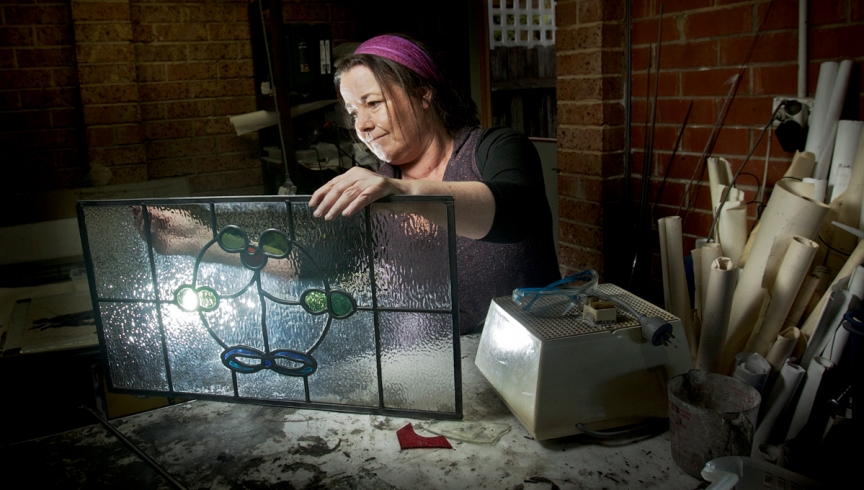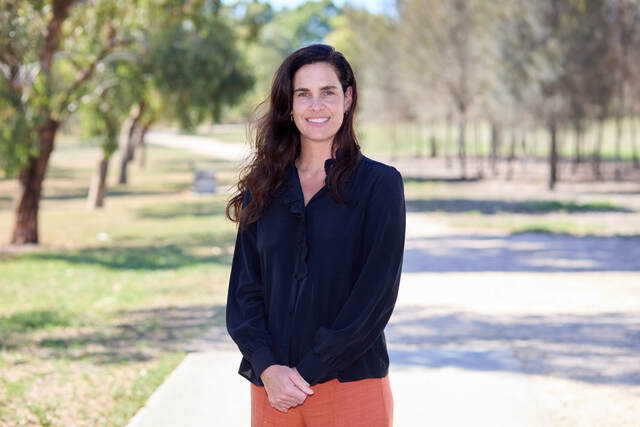In a world of convenience, mass production and quick fixes, some people are bucking the trend and maintaining traditions and skills handed down through generations.
We capture in pictures four people whose work is decorating Melbourne homes and buildings.
Click or swipe through the carousel above four our picture gallery.
Leadlighter Debbie Balen
Debbie Balen has always loved the colours in glass. “When I drove past a leadlighting studio and saw they were running classes, I gave it a go,” she says.
At the time Balen worked full-time in sales and marketing with a leather goods company.
It was another 10 years before she handed in her notice to concentrate on leadlighting and to start her business, Purple Dog Leadlights.
These days Balen’s studio is filled with glass in shades such as peppermint, muted yellows and cherry red, as well as the lead strips that are wrapped around each piece of cut glass to form a picture, like a jigsaw puzzle.
“I like taking a piece of glass that is lifeless and turning it into something that has soul,” says Balen.
“When you do it well, it’s almost breathing and it becomes an art form.”
She started Purple Dog Leadlights after completing a three-year Certificate III in stained glass at Holmesglen TAFE, one of the few institutes in the country to offer the course.
“My very first course was basic – I made a small leadlight panel – but it taught me cutting skills and about the process,” Balen says. She also talked to older and more experienced leadlighters about how they worked. Some of them shared secrets and knowledge.
Balen learned how to repair old leadlights and stained glass, as well as design and create new works for houses across Melbourne. Sometimes she is asked to restore and repair old works.
“I had an interesting job in Mont Albert in one of the first homesteads in the area,” she says.
“It was an intricate door panel that was in need of attention. It was over 100 years old and made with mouth-blown glass but some pieces were broken and the glass was dull.”
A team of three delicately removed the panel and transported it to Balen’s studio.
She spent hours cleaning the glass with water and cotton buds. Parts of the door panel were re-leaded and a special clear glue was used to repair the cracked glass.
“You still see the crack but the glass won’t break further,” she says.
The window was also re-puttied to make it waterproof, and reinstalled.
Plasterer Lyndon Hopkins
When the Hopkins family sailed from Britain and settled in Melbourne in 1857, they began a stonemasonry business in Williamstown.
“It was quite lucrative then as there were a lot of deceased passengers arriving on ships from England, killed by scurvy and horrible diseases,” says Hopkins.
The family also tried their hand in the Victorian goldfields before opening an ornamental plastering business that now operates in Dandenong.
“The family were traditional solid plasterers but the skill is disappearing. We have seven people in our factory, most of them are aged in their 50s and there is nobody coming through to learn the craft from them,” says Hopkins.
The family’s work can be seen in Melbourne’s elaborate private homes and in places such as the Regent and Princess theatres. “The magnificent columns and cornices and enrichment decoration in gold leaf is ours,” says Hopkins proudly.
The plasterwork is made with raw plaster of Paris mixed with water and chopped fibreglass reinforcement. The wet mix is poured into fibreglass or rubber moulds until it is set. As well as heritage-style properties, Hopkins and his team, including craftsman Zoran Bogdanovic, have made finishes for Audi showrooms and Alannah Hill and Bardot stores.
But a lack of young talent, a lack of appreciation of old craftsmanship and cheap imports are taking a toll.
“In years gone by we did a lot of renovations. People bought an old terraced house and they’d restore the old mouldings and archways. Now people look at an old house, bulldoze it and build something totally foreign to the area that doesn’t have those old mouldings and cornices,” says Hopkins.
“It’s great to walk through the city with my kids and say, ‘See that, your great-great-grandfather was involved in building that’. But I don’t think this business will carry on past myself. We have plaster moulds over 100 years old on our factory floor. Where will they end up?”
Upholsterer Mark Castaldi
When Mark Castaldi left high school and was deciding what to do next, he remembered the hours he’d spent watching his mother sewing cushions.
Aged 17, he began a four-year apprenticeship at a French upholstery store.
“I didn’t like school much but I liked doing things with my hands,” says Castaldi, now owner of Martel Upholstery.
“I learned how to sew, how to cover a chair from start to finish, how to sew in springs and how to stitch edgework and do diamond button work – where you make a pattern with the fabric and the pleats form a diamond.
“These are traditional handworks that are dying out.”
In his workshop off Church Street in Richmond, Castaldi works with a team of upholsterers in restoring pieces of expensive furniture to their former glory.
Two imported and collectable Danish chairs are getting the full treatment. Castaldi has stripped off the old covers, repadded the chairs and sewn new covers.
“They are complex in the way they are constructed and how the fabric has to be applied,” he says.
Castaldi has also worked on Featherston chairs – also collectors’ items.
“I enjoy getting something that is worn and not looking its best and transforming it to how it should look,” he says. “We keep things original-looking but with a new lease of life.”
Castaldi has also worked on restaurant fit-outs and he is pleased to have had two apprentices complete their training with him.
But he laments the lack of young people coming into the trade.
“That worries me – the skills won’t be passed on,” Castaldi says.
“I went to Paris recently and the upholstery trade there is quite buoyant. Here it seems to be fading away. It takes a bit of patience and time to develop the skills and maybe people don’t have as much of that these days.” \
Rugmaker Joy Marshall
Joy Marshall’s home is littered with colourful rugs, most of them designed by herself.
As a part-time family and community pastor in Canterbury, Marshall designs and makes her hooked rugs at night. She is soon to finish one of her own designs, a representation of the homes in L.M. Montgomery’s Anne of Green Gables books, that is made with hand-dyed recycled blankets hooked onto cotton monk’s cloth.
“I toured Canada in mid-2011 and was in a gift shop in Prince Edward Island when I saw my first traditional hooked rug. Later I noticed them when we visited some old homes in the area,” says Marshall.
“I loved the look and texture of the rugs and when I came home I looked into it but I couldn’t find anyone in Victoria making them. It was also hard to find the tools here. I couldn’t go to a local craftshop and buy what I needed.”
Marshall found the Australian Rugmakers Guild on the internet and taught herself the craft via online rugmaking videos from the US and the UK. Her first rug was a small 15 by 20 centimetres scene of a barn in a summer field – made with a kit from the US.
“I taught myself with that kit,” says Marshall. “There’s only one stitch you need to learn and the videos are good at pointing out mistakes that beginners usually make.”
It can take a month for Marshall to make a medium-sized rug and she designs them on her computer. She prints out the design and transfers it to the rug backing of hessian or cotton.
Hooked rugs were traditionally sewn on to potato sacks. Marshall buys blankets from op shops and then dyes them to get wool. The wool – the size of fettuccine – is then hooked through the backing with a tool like a crochet hook. Each loop helps hold the other loops in place.
“I’ve done crafts throughout my life – pastel paintings, quilting and miniatures for dolls’ houses. But I’ll be making rugs for many years to come,” says Marshall.







